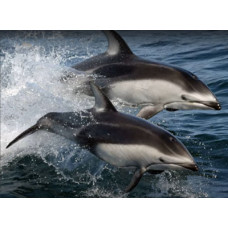Latin name
Lagenorhynchus obliquidens
Other names
Hookfin porpoise
Identification
The proportions and body shape are very similar to the Atlantic white-sided dolphin.
Each tooth is 4 to 5 mm in diameter. There are 30-32 pairs in the upper jaw and 30-31 pairs in the lower jaw. There are 74-75 vertebrae.
Features of fish fins
The dorsal fin of these dolphins is large, high and very curved, while the pectoral fins are thin and pointed.
Fish colouring
Upper body (except for two longitudinal light stripes), tip of snout, anterior parts of fins and tail blades dark. The lower part of the body (edge of the tail peduncle, belly, thorax, chin) is white. From the pectoral fin there are two black "belts": one to the corner of the mouth, the other to the lower ridge of the tail peduncle, serving as a boundary between the pale belly and the darker sides. Albinos are very rare.
Distribution
The dolphin's range extends from the cold to temperate waters of the North Pacific. Its habitat extends as far west as the South China Sea and as far east as the Baja California Peninsula. Populations are also found in the Sea of Japan and the Sea of Okhotsk. In the northern part of its range, some individuals may be found in the Bering Sea.
Habitat
Prefer deep waters of the platform and continental slope, temperate climate and open sea, except in some cases when it approaches coasts with submarine canyons. Observations of this species show that they usually stay 160 kilometers from the coast.
Size
Size and mass of females up to 2.21 m and 100 kg, males up to 2.3 m and 180 kg.
Behavior
Gathers in herds of up to a thousand individuals. Daytime activity. They like to approach ships. Jumping high out of the water, making arcs in the air. These dolphins respond not only to the distress signals of their relatives, but also to the cries of those caught in the nets.
They make a kind of migration - in winter they are most numerous in the east, in the southern part of the Gulf of California, and in summer - further north (in Oregon, Washington). They seem to prefer deep coastal waters throughout the year.
Pacific white-sided dolphins are known to sleep an average of seven hours per day.
Food and feeding habits
They feed on small gregarious fish and cephalopods. Their main prey is hake, anchovies, squid, herring, salmon and cod.
Reproduction
They have a polygamous breeding system and mate with multiple partners throughout their long lives of 37 to 46 years. Sexual maturity occurs when individuals reach 1.7 or 1.8 meters in length, which is between 5 and 6 years for females and 8 to 10 years for males. The seasons when most mating and births occur are spring and summer. The gestation period is about 11 or 12 months, and the only offspring are born weighing 15 kilograms and 1-1.2 meters long. The interval between births is long. A female may give birth to a calf every 2, 3 or even every 4, 6 years.
Fishing
Off the coast of Japan, some fishermen catch this dolphin. Due to the ban on the use of various types of nets, bycatch is decreasing.
Relationship with a person
They tolerate captivity well and are trainable in oceanariums.
| Classification | |
| Phylum | Chordata |
| Class | Mammalia |
| Squad | Artiodactyla |
| Family | Delphinidae |
| Genus | Lagenorhynchus |
| Species | L. obliquidens |
| Features | |
| Conservation status | Least Concern |
| Habitat | Pelagic |
| Life span, years | 46 |
| Maximum body weight, kg | 180 |
| Maximum length, cm | 230 |
| Sailing speed, m/s | No information |
| Threat to people | Edible |
| Way of eating | Predator |



